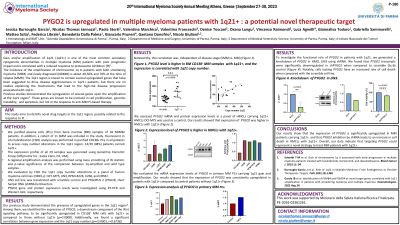Myeloma Novel Drug Targets and agents
Poster Session 2
P-180: PYGO2 is upregulated in multiple myeloma patients with 1q21+ : a potential novel therapeutic target.
Thursday, September 28, 2023
12:30 PM - 1:30 PM EEST

- JB
Jessica I. Burroughs Garcia, PhD
Post doctoral researcher
University of Parma
Parma, Emilia-Romagna, Italy
Introduction: Multiple myeloma (MM) is a hematological malignancy characterized by an accumulation of clonal plasma cells (PCs) in the bone marrow (BM). Gain and/or amplification of 1q21 (1q21+) is one of the most common cytogenetic abnormalities in MM patients with poor prognostic impact and correlated with a reduced response to proteasome inhibition (PI). Moreover, the incidence of the amplification of chromosome 1q in patients with pre-malignant smoldering myeloma (SMM) is about 40%. The 1q21 region is known to contain several upregulated genes that have been suggested to drive disease aggressiveness in 1q21+ patients. However, the mechanisms driving the high-risk disease progression associated with 1q21+ have not been identified. This study aims to identify new druggable targets in the 1q21 region.
Methods: We purified PCs from BM samples of 18 newly diagnosed MM patients. In addition, a cohort of 11 smoldering (SMM) was included in the study. Fluorescent in situ hybridization analysis was performed in purified CD138+ PCs in all patients to access copy number alterations in the 1q21 region. The expression profile of all 29 samples was generated using GeneChip ClariomD Arrays (Affymetrix Inc., Santa Clara, CA, USA). The smar package was used to identify differentially expressed genes between 1q21+ and control samples.
Results: Among the most significant upregulated genes in our analysis, we identified the expression of PYGOPUS 2 (PYGO2), a downstream component of the Wnt signaling pathway, to be significantly upregulated in CD138+ MM cells with 1q21+ as compared to those without 1q21+ (p= 0.0008). Additionally, we found a significant positive correlation between gene expression and the 1q21 copy number (p= < 0.0001, r= 0.6738), correlated with 1q21 copy number but not with disease stage (SMM vs. MM).
Moreover, we assessed PYGO2 mRNA and protein expression levels in a panel of MM human cell lines (HMCLs) carrying 1q21+. HMCL OCI-MY5 was used as a negative control. Our results showed that PYGO2 was higher in HMCLs with 1q21+. Furthermore, we evaluated the mRNA and protein expression levels of PYGO2 in HMCLs resistant to carfilzomib, showing that the expression of PYGO2 was consistently upregulated.
Next, to investigate the functional role of PYGO2 in patients with 1q21, we generated a knockdown of PYGO2 in HMCL JJN3 using short hairpin RNA (shRNA). We found that PYGO2 transcripts were significantly downregulated in shPYGO2 when compared to scramble control. Notably, cells lacking PYGO2 have an increased rate of cell death when compared with the scramble cell line.
Conclusions: In conclusion, our results show that the expression of PYGO2 is significantly upregulated in MM patients carrying 1q21+, and that PYGO2 inhibition by shRNA leads to an increase in cell death in HMCLs with 1q21+. Overall, our data indicate that targeting PYGO2 could represent a novel strategy to treat MM patients with 1q21+.
Methods: We purified PCs from BM samples of 18 newly diagnosed MM patients. In addition, a cohort of 11 smoldering (SMM) was included in the study. Fluorescent in situ hybridization analysis was performed in purified CD138+ PCs in all patients to access copy number alterations in the 1q21 region. The expression profile of all 29 samples was generated using GeneChip ClariomD Arrays (Affymetrix Inc., Santa Clara, CA, USA). The smar package was used to identify differentially expressed genes between 1q21+ and control samples.
Results: Among the most significant upregulated genes in our analysis, we identified the expression of PYGOPUS 2 (PYGO2), a downstream component of the Wnt signaling pathway, to be significantly upregulated in CD138+ MM cells with 1q21+ as compared to those without 1q21+ (p= 0.0008). Additionally, we found a significant positive correlation between gene expression and the 1q21 copy number (p= < 0.0001, r= 0.6738), correlated with 1q21 copy number but not with disease stage (SMM vs. MM).
Moreover, we assessed PYGO2 mRNA and protein expression levels in a panel of MM human cell lines (HMCLs) carrying 1q21+. HMCL OCI-MY5 was used as a negative control. Our results showed that PYGO2 was higher in HMCLs with 1q21+. Furthermore, we evaluated the mRNA and protein expression levels of PYGO2 in HMCLs resistant to carfilzomib, showing that the expression of PYGO2 was consistently upregulated.
Next, to investigate the functional role of PYGO2 in patients with 1q21, we generated a knockdown of PYGO2 in HMCL JJN3 using short hairpin RNA (shRNA). We found that PYGO2 transcripts were significantly downregulated in shPYGO2 when compared to scramble control. Notably, cells lacking PYGO2 have an increased rate of cell death when compared with the scramble cell line.
Conclusions: In conclusion, our results show that the expression of PYGO2 is significantly upregulated in MM patients carrying 1q21+, and that PYGO2 inhibition by shRNA leads to an increase in cell death in HMCLs with 1q21+. Overall, our data indicate that targeting PYGO2 could represent a novel strategy to treat MM patients with 1q21+.
